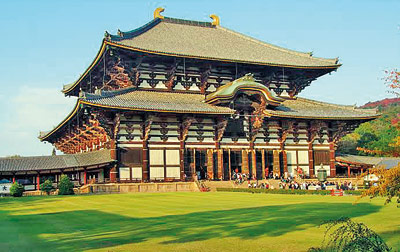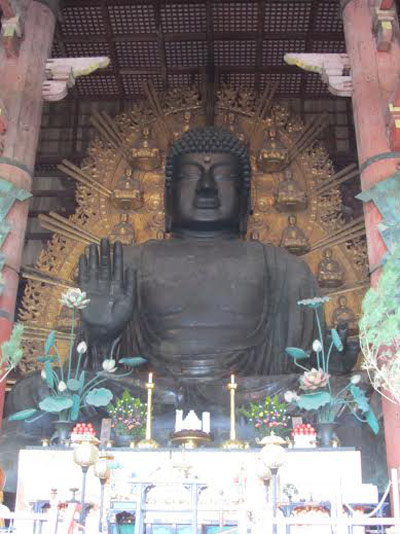Nara – In awe of ancient Japan
The ancient city of Nara, in the southwest of Japan’s largest island Honshu, is a must-see for any visitor to Japan. Nara became Japan’s first permanent capital during the 8th century and today has a rich collection of traditional sites, no less than eight of which have been granted UNESCO World Heritage status.

Todai-ji temple
It was the Emperor Shomu who, ascending the throne in 724 and placing his faith in Buddhism, strove to establish a Buddhist nation and set about building temples and monasteries.
Situated just a 40 minute train ride from Osaka, the city is compact – and its highlights can be visited in a day, many of the main attractions being accessible on foot from the Kintetsu-Nara train station.
Many of the important tourist attractions are situated in Nara-koen, the park in central Nara that extends from the downtown area all the way to the foot of the hills lying east of the city.
Lined with pleasant pathways and dotted with picturesque ponds, the park is home to a herd of semi-tame deer (Shika in Japanese) which have become a symbol of the city.
It is estimated that there are over a thousand roaming freely within the park. They are usually tame and like to be fed by visitors – but they can sometimes become a bit over enthusiastic in helping themselves to food in your hand even if the food was not intended for them!
The main attraction for us in Nara was the Great Eastern (Todai-ji) temple with its massive 15 metre high bronze Daibatsu (Giant Buddha) statue, the largest bronze casting in the world housed in what must be the largest wooden building in the world.
It is the sort of place that strikes you with its majesty as you pass through the gate into the temple grounds – you just stand there in amazement and gaze in awe at this magnificent edifice standing imposingly in front of you.

The giant Daibutsu statue
The temple also houses the Todai–ji museum in which some of the temple’s large collection of cultural treasures and religious art is displayed.
Isui-en garden (the name means “garden founded upon water”) is beautifully designed with ponds and plenty of trees blooming with flowers, conveniently located about fifteen minutes from the train station on the way to Todai-ji Temple.
There are usually some trees in bloom at whatever time of year you visit. Although there is an entrance charge, it is well worth paying this to take a leisurely stroll along the pathways that run all the way to the back of the garden so you can admire the serene beauty of this place.
Be sure to look out for the view of Todai-ji cleverly framed in the background.
The most important Shinto shrine in the city is the Kasuga-Taisha Shrine – the main buildings surrounded by a mysterious forest world with stone lanterns and wandering deer.
Like most Shinto shrines the centrepiece is the main hall (honden) which is the most sacred part of the building and the worshippers’ hall (haiden) – but it is the surroundings containing the traditional stone lanterns and the smaller auxiliary shrines that take you into a separate special world.
Another impressive building very close to the station is the Kofuku-ji temple, originally the family temple of the powerful Fujiwara clan with its 50 metre tall five story pagoda and its Museum of National Treasure which has some outstanding examples of 8th century Buddhist paintings.
Entrance to the temple grounds is free, but the Eastern Golden Hall and the recently renovated National Treasure Museum require you to pay an entrance fee.
The latter, housing the temple’s great art collection is a must-see if you appreciate Buddhist art – among the highlights here is the intriguing Ashura statue that has three faces and three pairs of arms.
Unfortunately the Central Golden Hall is under renovation and was not open to the public during our visit; the renovations are expected to take until 2018 to be competed.
Visiting Japan and not seeing the ancient capital of Nara is like visiting Sri Lanka and not visiting Anuradhapura and Polonnaruwa!


